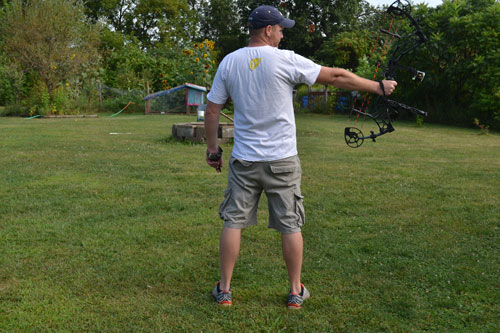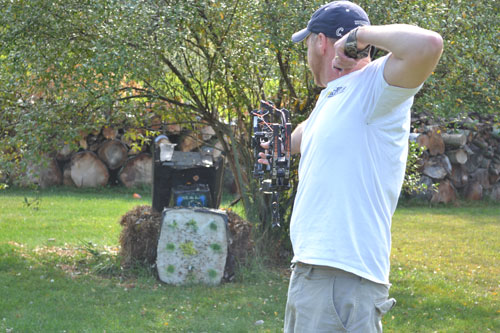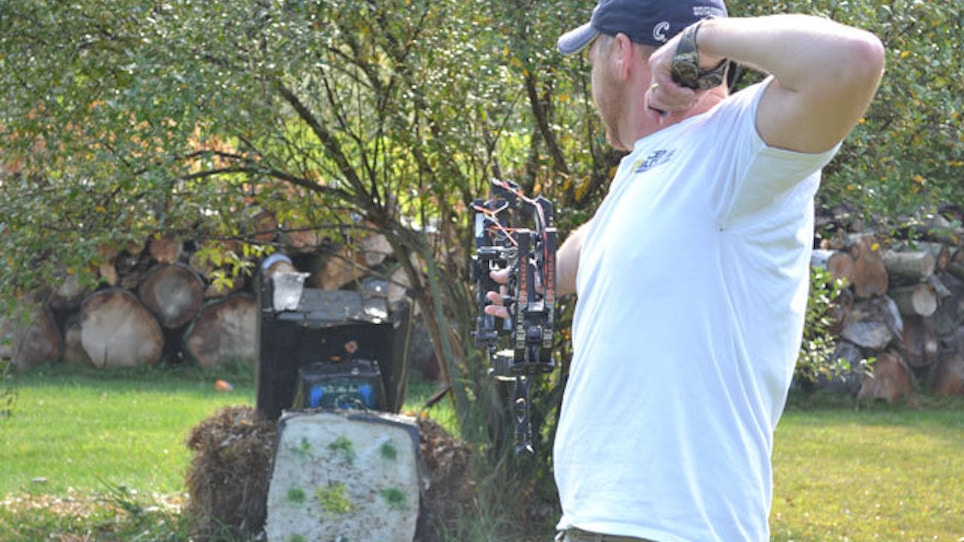Presented By ScentBlocker
By Scott Shultz
Previously 3 Steps For Proper Physical Positioning
My wife has several very fine horses that are professionally trained. In my amateur enthusiasm, I often comment to her about jumping on one of her horses and taking a ride. She will always correctly point out that you don't just go jump on — you first work them in the round pen to assure that they remember their training and you remind them of what’s expected once you're in the saddle. In many ways, shooting a bow correctly is the same way. The point is not shooting an arrow. The real focus is shooting an arrow correctly, perhaps for the first time. It does take a little "ground work" to know what we need to do, but once we get the feel of a correct shot, we will deliberately and carefully duplicate the process over and over.
 The difference of a proper shot, with proper form, including back tension, shot execution and follow-through, when compared to the scenario we described earlier in this article of slapping the trigger and collapsing on the anticipation of the shot, is about 180 degrees opposite! Yes, if you have any form of target panic (there are many), if you punch your trigger, if you cannot hold your sight pin on the target bull's-eye, or if you have a difficult time truly following through on a shot, you must surrender everything you have done wrong and everything you’ve practiced, perhaps for years, to perfect the problem. Contrary to the quip of Average Joes, the worst shot you will probably ever shoot while suffering from ill-fitting equipment and improper form, is when under pressure — shooting at an animal!
The difference of a proper shot, with proper form, including back tension, shot execution and follow-through, when compared to the scenario we described earlier in this article of slapping the trigger and collapsing on the anticipation of the shot, is about 180 degrees opposite! Yes, if you have any form of target panic (there are many), if you punch your trigger, if you cannot hold your sight pin on the target bull's-eye, or if you have a difficult time truly following through on a shot, you must surrender everything you have done wrong and everything you’ve practiced, perhaps for years, to perfect the problem. Contrary to the quip of Average Joes, the worst shot you will probably ever shoot while suffering from ill-fitting equipment and improper form, is when under pressure — shooting at an animal!
Now for the good news: If you will just commit to this proper shooting style, all of those ailments above will disappear.
You are standing 10 feet from your archery target. Imagine your bow as a big rubber band. If you pulled this big rubber band back with your release, and there was no let-off as with today’s compound bows, you would be holding considerable weight and steady pressure on your release and release arm, as well as on your bow arm. Right? To hold this pressure stretched to full length, you would require your bow arm muscles to push forward. Make sense? You would require your release arm to pull back, right?
Now imagine holding steady with your bow like a big rubber band and holding the sight pin dead center on the center of the target, all while pushing and pulling to hold the big rubber band at full length. Now here’s where you must pay attention: While you are steadily holding your pin on sight, pushing and pulling, your buddy sneaks up behind you and touches the taut rubber band with a knife. What happens? Your bow and bow arm jump forward toward the target. Your release arm flies straight back; you’ll feel the compressing together of your shoulder blades. The entire shot was a complete surprise, and you did not have time to flinch, close your eyes or collapse. If you were shooting a real arrow from your rubber band bow, it would have been a perfect shot.
If you can picture in your mind the rubber band as your bow, you’ll have the picture of what we will attempt to accomplish and what equates to a perfect bow shot. Amazing. Simple. But true.
Now, how do we convert that mental image into a real-life bow shot? At first, it may be a little tougher, but not much. Standing 10 feet in front of your archery target (make sure there’s a crisp, clean, bull's-eye target to aim at), assume the proper stance and posture as we discussed earlier. Go to full draw and place your 20-yard pin dead-center in the middle of the bull's-eye target. Next, wrap your trigger finger lightly around your release trigger (your release must be set light). It will take a few tries until you determine how much you can wrap around that trigger without setting it off. I recommend engaging the trigger up to the second crease in your trigger finger.
So let’s stop there. A snapshot would show you standing at full draw, assuming perfect stance and form, aiming dead-center at the bull's-eye, with your finger wrapped around the trigger. I know that advancing to this point for many is a major hurdle, so just hold this picture for a while and enjoy the new feel while overcoming the long-practiced urge to punch the trigger and collapse!
Let’s assume you are shooting a 70-pound bow with typical 85 percent let-off. My calculator indicates you are holding 10.5 pounds of actual draw weight, minus the mass weight of the bow itself. If you have shortened your draw length as necessary so your bow fits you correctly, your bow arm is now slightly bent at the elbow, never extended or locked out straight. There’s an essential reason and a need for the arm to be bent — so that it can push forward and have room to expand.
You are at full draw, sight pin steady on the center target, trigger finger gently wrapped around the release trigger, bow arm slightly bent at the elbow, holding back 10.5 pounds. Now it’s time to begin the actual shot. Gently apply pressure (muscles), pushing and pulling; pushing forward toward the target with your bow arm and gently pulling straight back with your release arm. If you had a scale integrated into your release, it would begin to increase: 10.5 pounds, 11 pounds, 11.5 pounds, 12 pounds, etc. While you are applying pressure forward and rearward, there is not an actual “pulling the bow back further.” Today’s bows have a solid “wall,” and when you are against that wall, there is not too much more “draw” left in the bow. What you are doing as you apply muscle forward and rearward is to increase tension and pressure within your form. This is critical to understand what is required and expected from the "push and pull" aspect.
About this point, assuming your trigger finger is wrapped around the release trigger and you are gently pulling back, increasing more and more tension within your form, the release should go off. Just like a knife to the rubber band, you should be totally surprised by the shot and the arrow will fly perfectly as you have been holding dead-center on the bull's-eye.
You may say, well, my release won’t go off until I squeeze (or punch) the trigger. If it is set lightly, yes, it will. This indeed takes some feel and some practice, but as you push and pull, tension builds on your release finger and the release will go off. When this happens, your bow will jump forward and your release arm will fly backward. Relax and smoothly allow it all to happen, which is called “follow-through.”
This is quite a challenge for many archers, as understandably they have practiced for years the timing and coordination of drifting the pin onto the target and hammering the release. I call it the "drive by" technique. This is why I stated earlier that this instruction will be a 180-degree departure from normal for some. I promise this is good advice and it can be done, and done well, if you try.
There is a wonderfully coordinated relationship that is established between the brain, the bow arm, the target and the sight pin and the dominant eye. The eye looks through the peep sight and lines up the sight pin and the target while talking to the bow arm, sometimes coaxing the bow arm, hold steady, hold steady. The goal and desire is to experience the sight pin locked solidly on the target with the bow arm holding solid as a rock. Then the brain says, release arm, these other guys are steady and ready to go, start to pull. Bow arm, hold steady and start to push. Steady. Push. Pull. Steady, Push. Pull.
When I used to compete, I was occasionally in an opportune situation that if I made one final but very difficult shot, I would win the tournament, win a bunch of money, or even more so, win a national tournament or shoot a perfect score. It is hard to do. It is indeed a ton of pressure. There is no other way I know of but for me to talk myself through it…Steady. Push. Pull. Keep pulling, keep pulling, steady, steady…and finally, off the shot would go.
 Likewise, a few years ago in Tanzania, my trusted PH turned to me from his perch behind a large termite mount as he carefully glassed a bedded herd of cape buffalo and whispered, “Bwana, he’s 94 yards, we cannot get any closer — you must make the shot!” Imagine the talking I did to myself when that huge old buffalo bull stood up and stood broadside. My Leica Geovids said 94 yards…and they do not lie. I tugged back a 90-pound bow loaded with a 635-grain buffalo arrow that had the trajectory of a gliding helicopter! I was tired, my muscles did not want to pull and they did not want to push or to hold steady. But for a moment, one time, you give it all you’ve got. Push, pull, hold steady. Pull, pull, hold, keep pulling… Thunk! The release went off, the bow jumped forward, my release arm flew back, and the big arrow arched toward the old buffalo bull. What seemed like forever, the arrow finally came back into earth’s orbit and buried deep, right in the bottom of his heart! I relate these stories not to brag, but to validate that this style of shooting really works, even in the most tense and stressful situations you can ever imagine.
Likewise, a few years ago in Tanzania, my trusted PH turned to me from his perch behind a large termite mount as he carefully glassed a bedded herd of cape buffalo and whispered, “Bwana, he’s 94 yards, we cannot get any closer — you must make the shot!” Imagine the talking I did to myself when that huge old buffalo bull stood up and stood broadside. My Leica Geovids said 94 yards…and they do not lie. I tugged back a 90-pound bow loaded with a 635-grain buffalo arrow that had the trajectory of a gliding helicopter! I was tired, my muscles did not want to pull and they did not want to push or to hold steady. But for a moment, one time, you give it all you’ve got. Push, pull, hold steady. Pull, pull, hold, keep pulling… Thunk! The release went off, the bow jumped forward, my release arm flew back, and the big arrow arched toward the old buffalo bull. What seemed like forever, the arrow finally came back into earth’s orbit and buried deep, right in the bottom of his heart! I relate these stories not to brag, but to validate that this style of shooting really works, even in the most tense and stressful situations you can ever imagine.
This is the exact same form that the Olympians shoot with, but with recurve bows without let-off, their release and reaction is more like that rubber band example with exaggerated follow-through and extreme accuracy.
In conclusion, I've attempted the somewhat difficult task of coaching you through written words, attempting a total change of your shooting style, disrupting years of practiced muscle memory and repeated thought process. Normally, I would be standing beside you and this process would take lots of patience and a few days of sincere effort on both our parts. But the basics are here for you — if you will work hard, concentrate and apply them to a new and greatly improved shooting style, you will amaze yourself by the results. Honest results that will transcend from the backyard practice range with you up the tree, up the mountain or in a tournament. Will you shoot perfectly every time? Do I shoot perfectly every time? Of course not. But together, if we talk ourselves through these high-pressure shooting situations, the results will be far fewer errant shots, the odd wounded animal will be the exception rather than the norm, and archery will become an enjoyable sport and we can have true confidence in our shooting ability. And who knows, maybe together we can put that guy with the trained tracking dogs out of business!
Here’s a little bonus: If you flinch and punch your bow release, unbeknownst to you perhaps, you probably also have trigger control issues with firearms or crossbows, as the punching and flinching reflex and habit often carries over from one discipline to the other. Fix one, and you'll see marked improvement in all areas.






